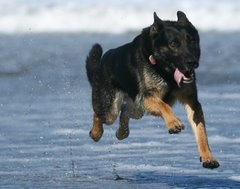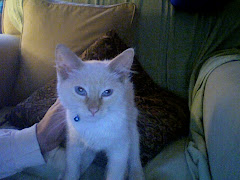Head halters (Gentle Leader, Halti) have gained in popularity over the years as the perfect, non-abusive way to train your dog not to pull on leash. The dog training world is so fragmented these days, it's hard to figure out which "tool" to use or "method" to follow. Head halters, along with no pull harnesses, are popular with positive only trainers (I will define a positive only trainer as one who concentrates on bringing about good behavior through the use of positive reinforcement-rewarding with food, toys, etc. while ignoring bad behavior and avoiding the use of aversives such as a collar correction). If you put a bunch of dog trainers in a room and start talking about training collars, without a doubt the controversy over head halters vs. other types of collars will spark quite the debate.
People often ask me why I do not use or recommend head halters in training. After all, they work on even the most powerful dogs with the owner barely pulling on the leash. I do not doubt they work on most dogs but I am convinced they are not a training tool and provide marginal management at best.
I don't like or use the gentle leader for several reasons:
1. Dogs hate it.
Why do they hate it? It gives constant pressure around their muzzle if they even slightly move forward, and, since a dog's muzzle is extremely sensitive (unlike his neck), this is uncomfortable in the least. Why would I put something on my dog he obviously finds immediately aversive? If I won't put it on my dogs (and I have used it on both of them), I'm certainly not going to recommend it to a client.
2. The potential for injury and misuse are considerably high-imo, higher than with a prong collar. Injuries associated with the head harness include cervical injuries due to the torquing of the neck if the dog lunges, for example. I've also seen people correcting dogs with the GL (giving leash tugs/pops). In the GL insert material, it even tells owners how to tug upwards to get the dog to sit. One positive only training class I took many years ago, said we could 'gently' pull the dog's head towards us to make him look at us.
3. It's advertised as 'scientific and positive' based on how a 'pack leader' or mother wolf firmly grasps a subordinate wolf around the muzzle. First of all, when dogs or wolves do this, it is a quick correction...not a constant source of pressure & aggravation at best or pain at worst. The GL material also states they got the idea from how equestrians handle horses with halters and that equestrians don't use prong collars on a horse's neck. This is true but look at the physiology of a horse's (a prey animal, btw) head. Also, equestrians may not use prongs, but they most certainly use various metal bits in a horses's mouth to gain control when riding. Very few equestrians ride untrained horses in halters! Bottom line...Dogs are not horses.
4. Head Halters are not a training device at all. They are a management tool (and I am not against management tools while owners learn the skills they need to change their dog's behavior, but this is one I avoid as it rarely leads to success-a dog who does not pull while not wearing it!) only and it's very difficult to transfer from a GL to a regular flat collar. I have never had that problem with a prong.
I've used GLs and haltis on my own dogs and seen the result of their use on countless others. They either completely shut down (no matter how many treats or time I gave them to get used to the halter) or fought it. I have not had that reaction with any other type of training collar. Why would I use something on my dog that he immediately finds aversive? I choose not to use it or recommend it to clients. Of course, some dogs will not find it aversive, but usually those are not the dogs that I see for training!

















